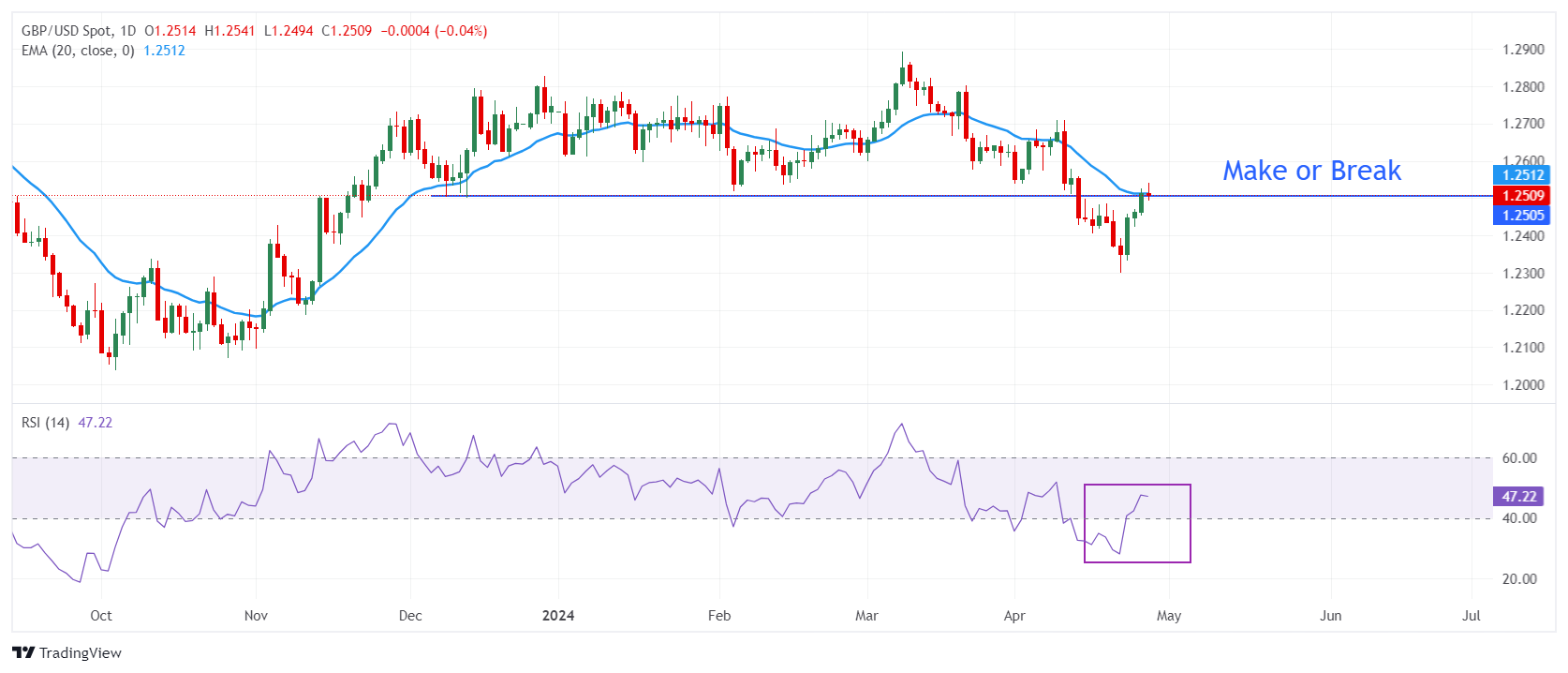Pound sterling exhibits strength ahead of US core PCE Inflation
- The Pound Sterling remains upbeat against the US Dollar ahead of the US core PCE Price Index data.
- Weak US Q1 GDP data has kept the US Dollar on the back foot.
- The UK service sector’s upbeat outlook has increased fears of persistent inflation.
The Pound Sterling (GBP) clings to gains near 1.2500 against US Dollar (USD) in Friday’s London session. The GBP/USD pair shows strength as recent survey data has shown an improved economic outlook for the United Kingdom even though the Bank of England (BoE) is maintaining interest rates higher.
The preliminary PMI report from S&P Global/CIPS for April released on Tuesday showed that activity in the services sector remains robust, pushing overall activity higher despite a lagging Manufacturing PMI. The data also showed that new business inflows in the service sector remain strong.
Higher demand for services tends to boost employment and wages in the sector, contributing to inflation pressures. This could stall progress in inflation easing to the desired rate of 2%. Also, BoE policymakers have remained worried about high service inflation. Currently, the UK annual service inflation is at 6%, higher than what is required to be consistent for bringing down inflation to the 2% target.
A few BoE policymakers see inflation receding sharply in upcoming months but still refrain from providing a concrete time frame for interest-rate cuts. In the press conference after the last monetary policy meeting, BoE Governor Andrew Bailey said market expectations for two or three rate cuts this year are not “unreasonable”.
Daily digest market movers: Pound Sterling hovers near 10-day high of 1.2500
- The Pound Sterling holds strength near a ten-day high at around the psychological figure of 1.2500 against the US Dollar. The Cable remains upbeat as the US Dollar has come under pressure after the preliminary United States Gross Domestic Product (GDP) growth in the first quarter turned out weaker than expected.
- The US Bureau of Economic Analysis (BEA) reported on Thursday that the economy expanded at a slower pace of 1.6% in Q1, below expectations of 2.5% and the prior reading of 3.4%. Despite the data miss, traders maintain strong bets for the Federal Reserve to start reducing interest rates from September or in the fourth quarter as the GDP Price Index was significantly higher. The inflation measure rose to 3.1% from the prior reading of 1.7%.
- Meanwhile, investors shift focus to the core Personal Consumption Expenditures (PCE) Price Index data for March, which will be published at 12:30 GMT. Core PCE inflation is expected to have grown steadily by 0.3% on a month-on-month basis, with annual figures softening to 2.6% from the 2.8% recorded in February.
- Stubborn inflation data could allow the Fed to maintain a hawkish rhetoric. Fed policymakers have been reiterating that interest-rate cuts are only appropriate when they are convinced that inflation will return sustainably to the 2% target.
- After the underlying inflation data, investors will focus on the Fed’s monetary policy decision, which will be announced on Wednesday. The Fed is widely anticipated to keep interest rates unchanged in the range of 5.25%-5.50%. Investors will keenly focus on the Fed’s guidance for interest rates.
Technical Analysis: Pound Sterling trades close to 1.2500
The Pound Sterling trades near Thursday’s high at around 1.2500 against the US Dollar. The GBP/USD pair struggles to extend the upside above the 20-day Exponential Moving Average (EMA), which trades around 1.2510.
The 14-period Relative Strength Index (RSI) rebounds above 40.00, suggesting that a bearish momentum might have concluded for now. However, the long-term bearish bias remains intact.
A sustainable move above the psychological resistance of 1.2500 will drive the pair towards the 200-day EMA, which hovers around 1.2550. On the other side, a downside move below Wednesday’s low at around 1.2430 will expose GBP/USD to a five-month low at around 1.2300.


